 James Reese Europe (February 22, 1880 to May 9, 1919) | |||
 Compositions Compositions | |||
|
1904
Blue-Eyed SueMy Heart Goes Thumping and Bumping for You Nubiana Arizona [1] Come, Cinda, Be My Bride [1] Zola (Jungle Song) [2] 1905
Obadiah (You Took Advantage of Me)The Coon Band Parade 1906
On the Gay Luneta
1907
A Royal Coon [2]The Black Politician: Musical [4] When I Rule the Town Spooney Sam The Darktown Band Help Yourself Don't Take Him Away Races, Races Hezekiah Doo The Smart Set Carbineers Society Lolita I Don't Like School Old Black Crow Likin' Ain't Like Lovin' Election Time Take Him Away, the Law Commands It When the Moon Plays Peek-A-Boo Suwanee River 1908-1909
The Red Moon: Musical [3]I Ain't Had No Lovin' in a Long Time Ada, My Sweet Potater! Sambo Picaninny Days (1909) Red Moon [Possibly by JRE] (1909) Pliney, Come Out in the Moonlight (1909) 1910
Sweet Suzanne [5]Queen of the Nile [5] That Minor Strain [6] Breezy Rag [Unpublished] (c.1910) 1911
The Clef Club: Grand MarchThe Separate Battalion: March Strength of the Nation: March Lorraine Waltzes [Ded. to Lorraine Europe] 1912
Hula, Hawaiian DanceDroop Dem Eyes [7] I've Got the Finest Man [7] Oh, Silvery Star [7] 1913
Someone is Waiting Down in Tennessee [8]A Hot Step Benefactors: March 1914
The Nell Rose WaltzValse Marguerite Fiora: Waltz |
1914 (Cont.)
Castle House RagCastles in Europe: The Innovation Trot Castle's Half and Half [6] The Castle Walk [6] Castle Maxixe [6] Castle Innovation Tango [6] Castle Perfect Trot [6] The Castle Combination: Waltz [6] Congratulations Valse (aka Castle Lame Duck Waltz) [6] Enticement: An Argentine Idyl [6,23] [as Eporue and Yenbad] Ballin' the Jack (Instrumental) [w/Chris Smith] What it Takes to Make Me Love You - You've Got It [9] 1915
Monkey-Doodle: CakewalkQueen Louise: Hesitation Waltz Hey, There!: One Step Hi, There!: One Step [same?] Rouge et Noir Myosotis: Waltz The Castle Doggy: Fox Trot [6] At That San Francisco Fair [6,10] Boy of Mine [6,94] Father's Gone to the War [7] I'll Hit the Homeward Trail [7] I Must Have Someone who Loves Me [7] Someday You'll Want a Home of Your Own [7] Follow On: March Song [7] Syncopated Minuet [7] Rat-A-Tat Drummer Boy [7] Wait for Me [7] Tinkle a Little Tune [7] 1916
Hilo (Hawaiian Waltz)1918
Good-bye My Hone, I'm Gone [11]I've Got the Lovin'es' Love for You [11] Mirandy (That Gal o' Mine) [11] 1919
Jazz Baby [11]Goodnight Angeline [11] On Patrol in No Man's Land [11] All of No Man's Land is Ours [11]
1. w/William Estren
2. w/"Jolly" John Larkins 91. w/Ernest Hogan 3. w/Bob Cole 4. w/R.C. McPherson 5. w/Henry Troy 6. w/Ford Dabney 7. w/Henry Creamer 8. w/Cecil Mack 9. w/James Weldon Johnson 93. w/Ford Dabney as Epoure and Yenbad 92. w/Chris Smith 94. w/Gene Buck 10. w/Jerome Kern & Schuyler Greene 11. w/Noble Sissle & Eubie Blake | ||
 Selected Discography Selected Discography | |||
| |||
Born in the deep south in Mobile, Alabama, James Reese Europe would eventually become a major influence on the role of black music in ragtime-era America through both his compositions and his efforts to bring respect to the race. He was one of six children of musical parents Henry Jefferson Europe and Lorraine N. Saxon, including older sisters Minnie (1868) and Ida (1870), older brother John Newton (10/9/1875), and younger sister, Mary Lorraine (10/1883). While 1881 has often been cited as his birth year,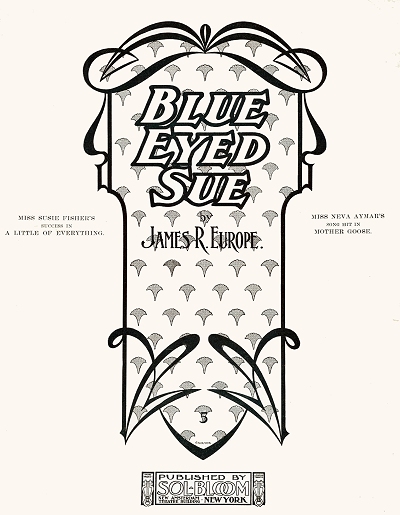 James appears quite clearly in the June 1880 census taken in Mobile, showing as 2 months old (only off a little bit), making it clearly 1880.
James appears quite clearly in the June 1880 census taken in Mobile, showing as 2 months old (only off a little bit), making it clearly 1880.
 James appears quite clearly in the June 1880 census taken in Mobile, showing as 2 months old (only off a little bit), making it clearly 1880.
James appears quite clearly in the June 1880 census taken in Mobile, showing as 2 months old (only off a little bit), making it clearly 1880.Raised in the post-slavery era, James was likely exposed to both classical and black forms of music from an early age. His father had multiple jobs, working as a barber, newspaper reporter, schoolteacher, Baptist minister, and finally with the Mobile Post Office through a Federal reconstruction program. His mother was a teacher and did music for the Baptist church as well. When James was nine the family moved north to Washington, D.C. as his father got a job with the National Postal Service. It was there that James received formal training in the violin from the master Enrico Hurlei, who was at the time the assistant director of the Marine Corps Band under John Philip Sousa. He also started composing in his teens, and even entered a composition contest at one point, earning a second-place award to his younger sister Mary. James received training as well in the M Street High School drill company, serving as the color sergeant. By the time the 1900 census was taken, James' father Henry had passed away a few months prior. James was not enumerated in his mother's home, but a city directory of the same year showed him working as a porter and still residing at her address. Whether or not he met fellow Washington, DC, composer Ford Dabney, three years his junior, during his tenure in that city is unclear.
Europe ventured to New York City in 1904 where he would be based for the remainder of his life, save for war service, to help earn money for his family. He immediately became involved with the musical scene, playing in cabarets, and also composing for groups like the Memphis Students run by composer and performer Ernest Hogan. His first compositions appeared in print in in 1904 thanks to recently-relocated Chicago publisher Sol Bloom,
who was known as an equal opportunity individual. A couple more works would come out under Bloom's imprint over the next two years.
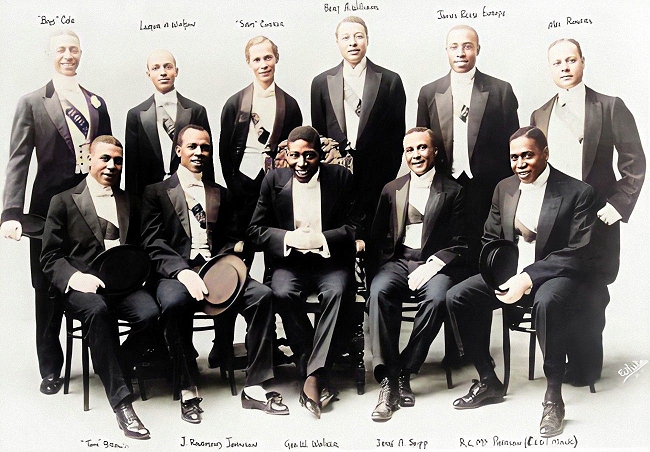 |
By 1907 Europe had become involved with the growing black musical theater movement in New York, which had ostensibly been started in 1902 with the ground-breaking show In Dahomey. Europe composed for and was the musical director of Cole and Johnson's The Shoo-Fly Regiment in 1907, and later for Bert William's Lode of Coal, perhaps the play that influenced famed showman Florenz Ziegfeld to hire both of them. Europe was also one of the charter members of the Frogs Club of New York, a high-profile group of black composers and performers. It was during this period that he also became associated with Ford Dabney, who had joined Europe in New York in early 1910. They were soon both playing for Ziegfeld's late evening show, Ziegfeld's Midnight Frolic, staged on the roof of the New Amsterdam Theater in Manhattan.
At this time there were only a few loosely formed black musician organizations, but no coherent force that was truly looking out for their collective best interests and employment. On April 11, 1910, Europe founded the legendary "Clef Club," New York City's all black musicians union, along with Dabney and composer/arranger Will Tyers. His goal was to create a coherent high-quality musical force in the city that could earn equitable fees for its members and garner better treatment from white employers, both private and public. In turn, he demanded the very best from all musician members, including the ability to sight read in several genres, and owning the best possible formal wear for engagements. For some time after, Europe and his Society Orchestra were the leading purveyors of dance music for New York's elite. A band for any occasion could quickly be formed from its formidable membership. It was Ford Dabney who introduced blues writer W.C. Handy to the Clef Club and Europe, with whom Handy became fast friends. Europe held Clef Club members to the highest standards of performance, demeanor, attitude, professionalism and overall appearance. While the Clef Club did not outwardly discourage ragtime performance, they did try to emphasize the member's skills in classical and popular song forms, particularly for society gatherings. It wasn't long before his organization, bolstered by some extraordinary public concerts, were not only commanding the best jobs in New York and surrounding areas, but many white musicians petitioned to join the formidable union as well so they might also find work.
With over 100 musicians, the Clef Club officially debuted at the Manhattan Casino in Harlem on May 27, 1910, to great acclaim. While Europe and others were mentioned in the reviews of the concert that included both classical and popular numbers, it was possibly Joe Jordan's That Teasing Rag which gave the group its biggest boost of the evening, in the New York Age, a paper with a largely white readership, on June 2, 1910:
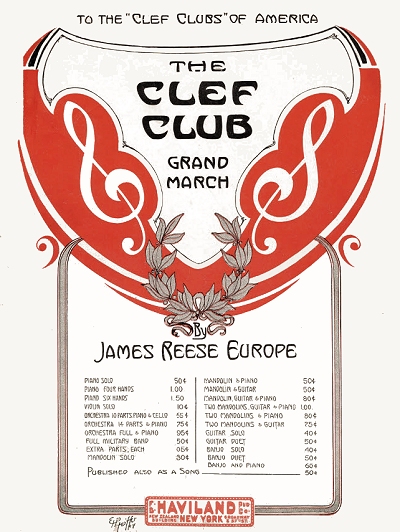
It is sometimes said of colored musicians that the only musical sign observed by them is forte, but to have heard the Clef Club Orchestra Friday evening would have disproved such an assertion. Pianissimo, moderato, crescendo, diminuendo and many other signs were given marked attention by these musicians, who clearly demonstrated that they are capable of playing music as it is written.
Good judgment was shown in the selection of the musical program. The large audience was not inflicted with any of the heavy operas on a warm summers evening, neither were all the numbers ragtime. Evidently it was the intention of the Clef Club to show that it was unnecessary to present heavy numbers to prove that the members know something about music, and that a fitting test of one's musical ability can often be made by properly playing popular pieces. It is to be hoped that they impressed [upon] some singers and musicians present that it is not always what you play, but how you play it. … The colored musicians showed their versatility by also playing ragtime; Joe Jordan's composition, "That Teasing Rag," which was played under the direction of the composer, came in for generous applause.
Within two years, on May 2, 1912, the Clef Club under Europe's baton brought their wide range of musical selections to Carnegie Hall, one of the first times ragtime was played in that famous formal setting. They would return in 1913 and 1914. During this period Europe continued to compose and turn out a number of popular numbers. There is some confusion that still exists about Europe's role in one of the big hits of 1913, Ballin' the Jack. The most consistent story is that it was one of those rare pieces in which the instrumental version came out of the song version, instead of the other way around which was a common practice during that time. Europe may or may not have been involved with the original song by Chris Smith and James Burris, but he evidently did help fill out the instrumental version of the piece in 1914 by tacking on a bouncy chorus from his song What it Takes to Make Me Love You - You've Got It at the end. Subsequent recordings and performances, including by Europe's own band, created a sensation, and the piece is still viable and performed often in the 21st century.
While still in Washington, DC, James had become acquainted with, and perhaps involved with entertainer Bessie Simms, who was born in that city. She was mentioned in New York papers as being in some of the same shows that James was working with from 1906 and later.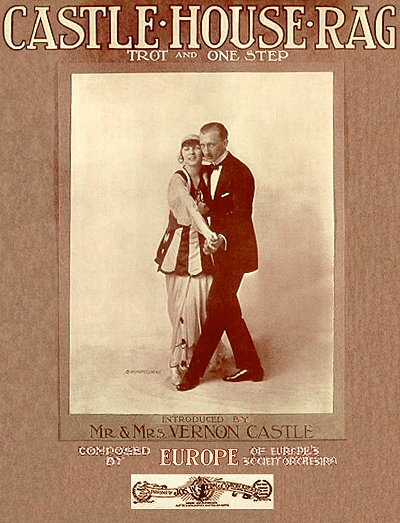 Over the next several years they had a stormy relationship at best that oscillated between passionate and contentious. A notice in the Indianapolis Freeman of February 3, 1912, posted a report that Europe had been shot by Bessie during an altercation, and was hospitalized in serious condition. No other reports of such an incident have surfaced, so it may have simply been a nasty rumor. In spite of their romance, Europe ended marrying Willie M. Angrom Starke, a recently widowed socialite, on January 5, 1913. Then, despite this union, Europe evidently continued to see Simms off and on, and she would bear his child, James Reese Europe, Jr., on February 2, 1917. There is no indication that Europe ever married Simms or divorced Angrom.
Over the next several years they had a stormy relationship at best that oscillated between passionate and contentious. A notice in the Indianapolis Freeman of February 3, 1912, posted a report that Europe had been shot by Bessie during an altercation, and was hospitalized in serious condition. No other reports of such an incident have surfaced, so it may have simply been a nasty rumor. In spite of their romance, Europe ended marrying Willie M. Angrom Starke, a recently widowed socialite, on January 5, 1913. Then, despite this union, Europe evidently continued to see Simms off and on, and she would bear his child, James Reese Europe, Jr., on February 2, 1917. There is no indication that Europe ever married Simms or divorced Angrom.
 Over the next several years they had a stormy relationship at best that oscillated between passionate and contentious. A notice in the Indianapolis Freeman of February 3, 1912, posted a report that Europe had been shot by Bessie during an altercation, and was hospitalized in serious condition. No other reports of such an incident have surfaced, so it may have simply been a nasty rumor. In spite of their romance, Europe ended marrying Willie M. Angrom Starke, a recently widowed socialite, on January 5, 1913. Then, despite this union, Europe evidently continued to see Simms off and on, and she would bear his child, James Reese Europe, Jr., on February 2, 1917. There is no indication that Europe ever married Simms or divorced Angrom.
Over the next several years they had a stormy relationship at best that oscillated between passionate and contentious. A notice in the Indianapolis Freeman of February 3, 1912, posted a report that Europe had been shot by Bessie during an altercation, and was hospitalized in serious condition. No other reports of such an incident have surfaced, so it may have simply been a nasty rumor. In spite of their romance, Europe ended marrying Willie M. Angrom Starke, a recently widowed socialite, on January 5, 1913. Then, despite this union, Europe evidently continued to see Simms off and on, and she would bear his child, James Reese Europe, Jr., on February 2, 1917. There is no indication that Europe ever married Simms or divorced Angrom.Among the best-known of Europe's pieces were eight that were co-composed with Dabney specifically for the famed husband and wife dance time of Vernon and Irene Castle, plus two others by Europe alone, one that would become his signature. The Castles found Europe's Society Orchestra among the best they had worked with, and hired Europe late in 1913 as their preferred band leader with Dabney as their arranger. He was intuitive and in tune with the duties of a dance conductor that Irene Castle later wrote, "[Europe's] was the only music that completely made me forget the effort of the dance." One of the eight pieces by Dabney and Europe, the Castle Half and Half, was written in 3/4+2/4, or actually 5/4 time, over 4 decades before that time signature would become popular through the efforts of Dave Brubeck and Paul Desmond. All of these were issued within a two-month period in 1914, an extraordinary output for the quality of work the two invested into the project. It was Europe's brisk Castle House Rag, however, that became the best known of the compositions associated with both the composer and the Castles themselves. Soon after this time, Europe left the Clef Club owing to disputes with some of the other members, and Dabney took on many of his responsibilities until he eventually formed his own orchestra.
Europe formed the Tempo Club with Dabney and Tyers after leaving Clef Club, and by the end of 1915 had left the Castles (now tended to by Dabney and Tyers alternately) to pursue other musical interests and composition. On September 18, 1916, he enlisted in the United States Army as a private and took officer training. After successful completion of the courses, he was asked by his regiment's white commander, Colonel William Hayward, about the possibility of forming a band for both performance and combat duties. It was Europe's formidable tenacity and reputation and allowed him to convince a number of musicians to join him in this endeavor. Among them were dancer William "Bojangles" Robinson, pianist Willie "The Lion" Smith,
and singer Noble Sissle who had already partnered briefly with pianist/composer James Hubert "Eubie" Blake, and would do so after the war on Broadway. Jame's company became the 369th U.S. Infantry "Hell Fighters" Band, and their reputation as both musicians and soldiers was second to none.
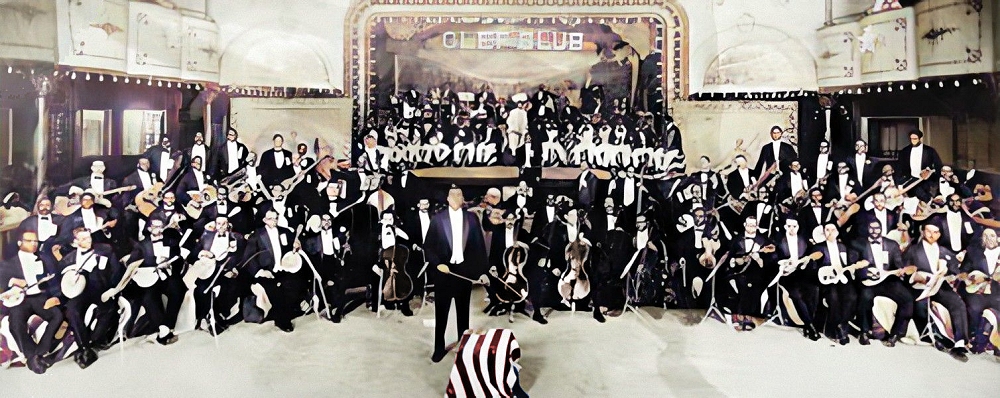 |
Lieutenant Europe's unit was the first all-black unit to enter France in on April 23, 1918, and where he stayed for the remainder of the war and beyond entertaining both troops and the local citizens. Unfortunately, in August 1918 a directive was passed down that all of the officers of a unit must be of the same race, which precluded Lieutenant Europe from continuing to lead the regiment. However, he was allowed to take his band to Paris for the remainder of the war and provide morale in the form of concerts for the French people. It was Europe who largely introduced what was becoming known as "jazz" to France, where it took hold and has never left. When the fighting stopped in November, Europe and his band were allowed to rejoin the 369th and continued performing in an official capacity.
In early February 1919, with his stellar reputation preceding him, Europe and his group received a warm hero's welcome back to the U.S. He then saw to publishing some of his songs about the travails of war, followed by time with the 369th Infantry band in the recording studio cutting several sides on four dates for the Pathé label. James then took the band on tour, where they ended up in Boston on May 9, just two days after their final recording session. The legend goes that it was there at Mechanic's Hall where one of his two drummers suddenly decided he had experienced enough of Europe's allegedly overbearing direction, and stabbed the leader during intermission, fatally cutting into his jugular vein. The truth, according to the account by Noble Sissle who witnessed the incident, is that Europe was likely breaking up a fight and was accidentally nicked in his jugular, dying later at a hospital from exsanguination. The outcry in the papers against this perceived murder, along with the clear public mourning underscored his societal acceptance and his clear ability to bypass the racial barriers that were so prevalent at the time. Europe was buried at Arlington National Cemetery with full military honors. His grave can be found in Section E Div Site 3576.
The 1930 census showed James Reese Europe, Jr., residing with his mother, now going as Bessie Johnson, living in Harlem. There is no indication that he ever went into the music business as a career, so his legacy was only in name. However, Noble Sissle and Eubie Blake often attributed their success on Broadway in the 1920s and 1930s to the foundation of respect for black musicians that was laid by Europe. One of the best belated tributes to James Reese Europe was the prominent recognition of his work in the 1943 all-black film Stormy Weather, which chronicled black musicians of New York, including Europe and W.C. Handy, through the first decades of the 20th century, although leaving most of the actors out of the film's credit, including Ernest Whitman who played Europe. Ford Dabney was reportedly a consultant for the project. Europe was further recognized and commended for his contributions in the 2001 Ken Burns documentary Jazz, and his music is still frequently used for ragtime dance demonstrations in the style of the Castles.